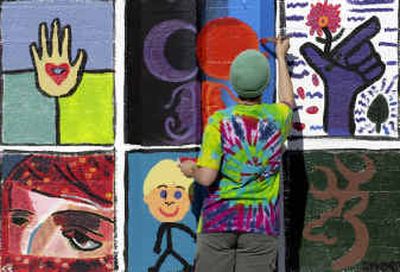Making your MARK

UNLESS YOU’VE BECOME STUCK in traffic under the Browne Street railroad viaduct in the last couple of weeks, chances are you haven’t noticed the vibrant and lively murals that decorate this previously bleak public space.
The Browne Street murals are the most recent addition to a larger program that got its start in 1991 when the downtown business community saw a need to bring color and light to dark pedestrian walkways in the viaduct tunnels.
Over the past 15 years, under the direction of the Spokane Arts Commission, the program has expanded to include existing public concrete structures that commonly have graffiti, such as freeway underpasses and other prominent locations in and around the city.
The newest People’s Gallery will be painted today on Perry Street between Second and Third Avenues under Interstate 90 across from Liberty Park, with everyone invited to participate.
Roots in WPA
In the United States, large-scale public murals date back to the 1930s when the Works Progress Administration, a New Deal program, hired out-of-work artists to create murals and other public art.
The concept was revised in the 1970s when major metropolitan areas, like Los Angeles and Philadelphia, were looking for ways to beautify their inner cities and get rid of unsightly graffiti.
Yet Spokane’s public mural program has expanded into much more than covering graffiti.
The projects are used as “incentives for local professional artists to work with youth in a mentor/student relationship,” said Karen Mobley, Spokane Arts Commission director, “and they are also ways for at-risk youth to engage in a positive, productive and creative process.”
Funding for all the individual projects in the mural program are “on a wing and a prayer,” said Mobley. “Basically it’s all private funding. We raise the money from grants, corporate contributors and individual people.”
Two projects in one
The Browne Street Viaduct Mural, between Sprague and Pacific Avenues, “was really two projects in one,” said Mobley.
“One side of the viaduct was painted by volunteers from the Spokane Mental Health New Bridge School where the kids worked together as a team with artist Rik Nelson,” she said. “The other side of the viaduct was a People’s Gallery organized with the People for People program of the House of Charity.”
Nelson—known locally for his intricate and inventive “quilts” made from recyclables like cereal boxes, soda cans and shampoo bottles—has worked on three city murals.
“My role was to find something of value to the kids and help them develop that into an artistic product,” said Nelson. “I met with the students and we talked about what they wanted to say.”
After deciding on the theme of “positive transformation,” the students developed a series of visual images.
Once on site, painting the mural was demanding work.
“It was miserable, cold and raining all week,” said Nelson. “The kids were developing new skills and using tools they were unfamiliar with. They were moving around scaffolding and lugging buckets of paint. They stayed with it and did a great job.”
Nelson said he came away from the project feeling humbled.
“These murals are testaments to the value of art in transforming lives,” he said. “The kids did something for their school and the community at large. In the end it was not about themselves, it was about the art.”
Ed McCarron, director of the House of Charity, said: “The art has added a different dimension to the whole neighborhood and uplifted the people who worked on it.”
In the House of Charity’s June newsletter, Jesuit volunteer Patrick Rossman wrote that the Browne Street bridge area had now been transformed from a dark and dreary place to “a bright and hopeful pathway.”
“It’s amazing,” he wrote, “to be witness to this project, to see people working together and taking great pride in their work. It’s truly a beautiful sight.”
People’s Gallery at Perry Street
Over the years, hundreds of individual artists have been a part of transforming the grimy walls of underpasses into beautiful spaces simply for the pleasure of those who are traveling through, and living in, Spokane.
Today, between 10 a.m. and 3 p.m., you have an opportunity to be one of those people.
The newest People’s Gallery will be painted on the I-90 underpass on Perry Street between Second and Third Avenues across from Liberty Park.
The walls of the underpass will be divided into 492 sections and each participant will be assigned their own piece of the wall to paint.
Kids and adults alike are encouraged to participate; parents must accompany children. Come dressed to paint and wearing closed-toed shoes or sneakers.
The Spokane Arts Commission will provide paint and brushes.
“It’s a wonderful thing to express yourself for all the world to see,” says Susan Hardie, outreach coordinator for the Spokane Arts Department.
“I have people tell me all the time how nice it is to come back and look at what they painted at a People’s Gallery years ago and know that it’s a part of the fabric of this city.”